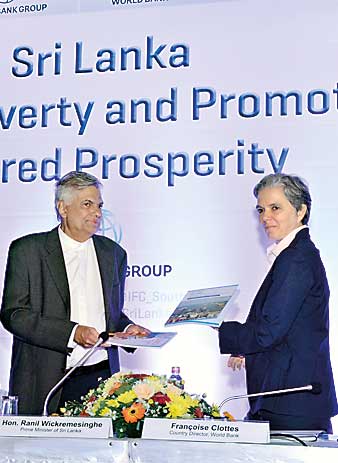17 Feb 2016 - {{hitsCtrl.values.hits}}
By Chandeepa Wettasinghe
 The government yesterday hinted at moving towards taxing capital, reversing its current tax policy approach of serving all—both super rich, rich and poor—with more or less with the same spoon.
The government yesterday hinted at moving towards taxing capital, reversing its current tax policy approach of serving all—both super rich, rich and poor—with more or less with the same spoon.
“Currently, most of the economy’s weight is borne by the masses, and not the capital owning class.
I think we require a capital tax,” Prime Minister Ranil Wickremesinghe said at the launch of World Bank’s research findings on poverty and prosperity in Sri Lanka.
He said that in the past 20-30 years, the economic development has created both the rich and the super rich, but the rich have continued to become richer, while the poor have got poorer.
The World Bank research too showed that income inequality has been on the rise since 2009/10.
“When I was small, my parents used to pay a lot of taxes. They paid a capital tax, estate duty, a capital gains tax, a wealth tax, a death tax and a vehicle tax. The equation seems to have reversed now,” Wickremesinghe said.
He added that the current equations of the bottom 80 percent of the citizens paying 80 percent of the taxes as well as the top 20 percent owning 80 percent of the capital have to be changed.
The Prime Minister’s wishes however seem to contradict the Budget 2016 policy of reducing personal and corporate taxes to one of the lowest in the world.
The Budget 2016 increased the personal tax threshold to Rs.2.4 million, somewhat helping to ease the income inequality, but the tax rate was fixed at blanket 15 percent.
Previously, personal taxes had been charged at a progressive rate, starting from 16 percent at a Rs.750, 000 income threshold, escalating to 24 percent.
While a mansion tax was brought on in the January 2015 Interim Budget, an increasing number of exemptions have been added on to the original proposal.
Poverty level falls; structural weaknesses remain: WB
Sri Lanka’s poverty levels have fallen to 7 percent, and yet structural weaknesses remain, the World Bank said yesterday, at the launch of new research findings into Sri Lanka’s poverty
and prosperity.
“It is encouraging to see poverty reduce between 2002-2013 through increased earnings. Even though only 7 percent live below poverty, around 40 percent of the population live near the poverty line with Rs.225 in earnings a day,” World Bank Senior Economist David Newhouse said.
He said that this ‘near poverty’ group must be supported, as they are always under the risk of falling below the line with even the smallest shock to the economy.
Newhouse also pointed out weaknesses in the estate economy.
The research revealed that pockets of severe poverty will remain and prosperity will depend on addressing chronic revenue shortfalls and fostering a more competitive and inclusive economy.
World Bank said that Sri Lanka has one of the highest healthcare, education and social protection programmes in the world.
“But government revenue is not enough to deliver on these promises,” World Bank Senior Governance Specialist Charles Undeland said.
He pointed out that revenue targets since 2009 have consistently fallen, much lower than the rosy budget predictions.
“The government should remove tax exemptions, simplify taxes, and reduce the tax thresholds,” he said.
Undeland added that the bottom 40 income percentile must be provided better jobs by providing them with skills that employers desire, but that revenue must be higher to embark on such investments.
Institute of Policy Studies Executive Director Dr. Saman Kelegama pointed out that even those who qualify to attend university cannot pursue a degree due to lack of space.
“Tertiary education is stagnant, and private sector investments have been ad-hoc,” he added.
Undeland noted that the 7 percent poverty figure does not include the recently recovered North and East, where the situation is worse, and requires spacial and social inclusion. He also said that income inequality has widened.
The research pointed out that recent gains have been seen through a 15 percent increase in ownership of a refrigerator in the bottom 40 percent of the population from 2006/7-2012/13, while the ownership of a cellphone increased 63 percent in the same period.
Further, electricity usage has increased 25 percent from 2002-2012/13.
“This shows that there has been development in the economy,” Undeland said.
However, the research fails to point out that most of these gains were achieved through commercial debt-fuelled construction growth, placing the macroeconomy under extreme strain.
Dr. Kelegama said that Sri Lanka must move away from its dependence from such non-tradable sectors.
26 Nov 2024 8 hours ago
26 Nov 2024 9 hours ago
26 Nov 2024 26 Nov 2024
26 Nov 2024 26 Nov 2024
26 Nov 2024 26 Nov 2024